About Palimpsest
My artwork is an exercise of historical review, a way to get rid of stereotypes that over centuries have ended up assimilating and reproducing. Painting the indigenous and his territory (that covers its cosmic and cultural space), trying to give him a place in the network of lines, layers, and colours, it’s a way to feel discomfort with what the imagination takes for granted, of altering and questioning the established hierarchies by a dominant culture. All these questions, pass through me as I knit the image: I try to bring to the fore what was once a utilitarian part of the landscape, I confront the daily space of the indigenous with the idealized representations of the European printings of the 16th century, and I tried to save from the tangle of the history a more detached and sensitive expression of the Other.
In supports such as cotton paper with rustic and irregular edges, with the raw and yellowish canvas that remembers the mouldy papers over time (denying the notion of an uncontaminated blank sheet as a start), I display free strokes, colour stains, to get the portrait of indigenous men and women as I see them. In the background, the Western figurative canons can be glimpsed. By not hiding them, I highlight their phantasmagoric character and the tragic permanence of the European imaginary that goes through everything.
From the sum of two, our several speeches, from this visual palimpsest, resulting from the ambiguous expression with the idea of indigenous in western culture is still trapped and which is nothing more than a mirror of what we are and deny.
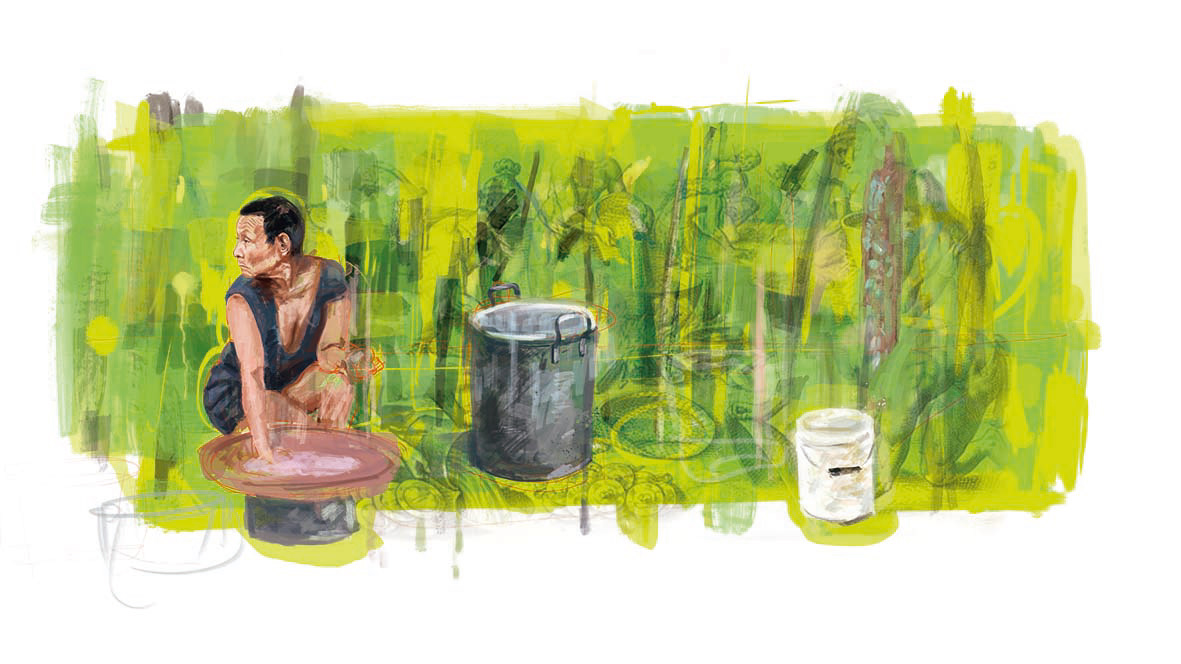
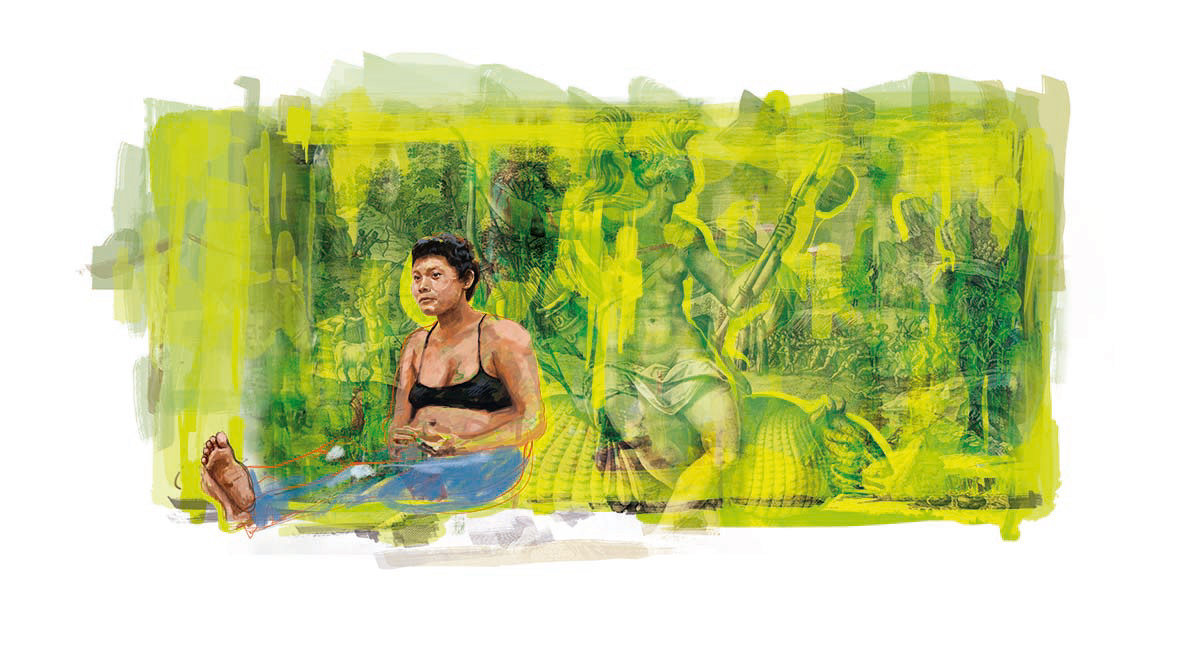
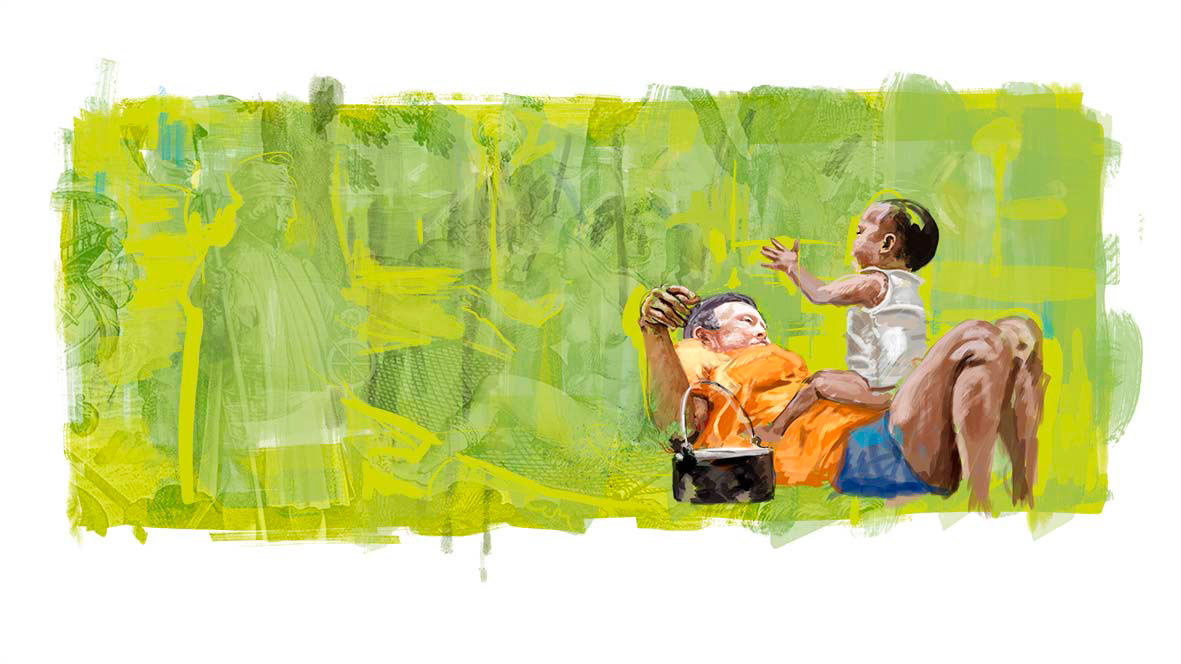
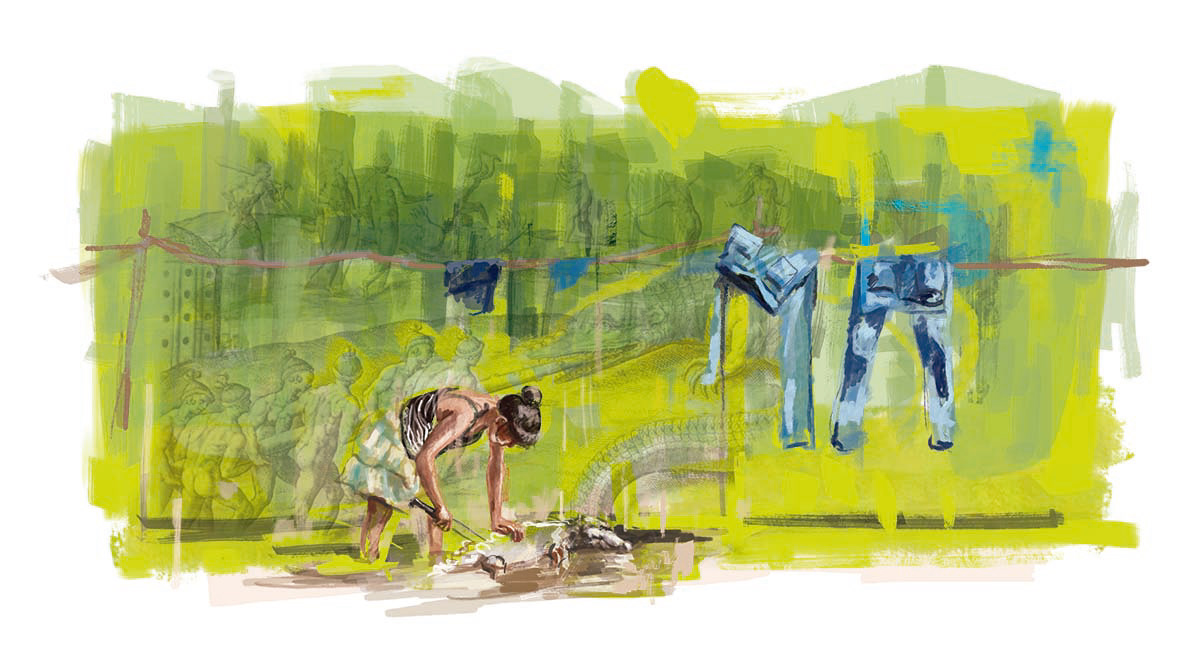
No one shall erase our smile
Thoughts on Jose Luis Cote’s Palimpsests
By: Professor Miguel Rocha Vivas
Thoughts on Jose Luis Cote’s Palimpsests
By: Professor Miguel Rocha Vivas
A Palimpsest is an overlay of stories and images. A rewriting is not always perceived by the naked eye, the ear nor the mind. The pictorial body of work created by Jose Luis Cote articulates palimpsests in which we manage to have a glimpse of socio-biological layers which add to the visual reasoning conducive to a critique of History, colonial persistence, the power of images and the new human as well as non-human “extractivist”.
The layers, cuts and mirrored visions exposed by Cote’s Palimpsests confront us, from the first series, with the daily realities of men, women and children from Amazonian Communities ( Tukano, Jiw , Nükak communities), withdrawn from Eden and the “good Savage” stereotype, as Cote himself would say. In the second series, we find ourselves faced with the elderly women of the high planes of the Sutatausa region, ancient remains of the Muisca indigenous people, laying on top of the background depicting paintings pertaining to colonial parishes in which are displayed both imageries of religious punishment as well as the submission of indigenous women, the “Cacica”, attired with a Muisca cloak.
In both series, the colonial erasure of the native memories is expressed in a programmed way within the re-location and re-coding of the indigenous corporeality and territories. In the piece Views of Nükak Women on the Interpretation of the Amazonian Woman according to a European (2017), belonging to the first series, two women gaze in opposite directions through the palimpsest. On one side, pictured in colour, a young Nükak woman dresses like the colonial woman, leaving behind the partial nudity of her ancestors. The Nükak people nowadays usually live in urban settlements following the dismantling of their former seasonal nomadic routes; after coming back into contact with other non-Nükak Colombians and foreigners in 1988, due to the pressure from “coca” growing settlers with intent to traffic, a great part of their grandfathers and grandmothers perished from illnesses such as the common cold. On the other side of the palimpsest, deriving from an engraving reminiscing the legendary Greek world appears indomitable and dressed for war: the mythical Amazonian woman. Even though both women are sitting, the Nükak woman is just there and stares at an uncertain horizon, whereas the Amazonian woman pierces her gaze firmly towards a world capable of being taken and defended by means of force; she is thus manifested as the European conquerors’ erotic and emotional allegory.
Within the translucent pendulum of the simple “being there” of the Nükak woman, and the opposing potentially aggressive state of being of the Amazonian woman, the tensions are amplified by the rewriting and erasure of the image itself. This un-idealized display overlaps to the idealized background and delivers a criticism of the exoticism present in the way of picturing and imagining indigenous women from the South American rainforests, named “Amazons” by the desire of those who called themselves advanced and conquerors, along with all the erotic burden falling on the bodies and territories named as they were.
Within the translucent pendulum of the simple “being there” of the Nükak woman, and the opposing potentially aggressive state of being of the Amazonian woman, the tensions are amplified by the rewriting and erasure of the image itself. This un-idealized display overlaps to the idealized background and delivers a criticism of the exoticism present in the way of picturing and imagining indigenous women from the South American rainforests, named “Amazons” by the desire of those who called themselves advanced and conquerors, along with all the erotic burden falling on the bodies and territories named as they were.
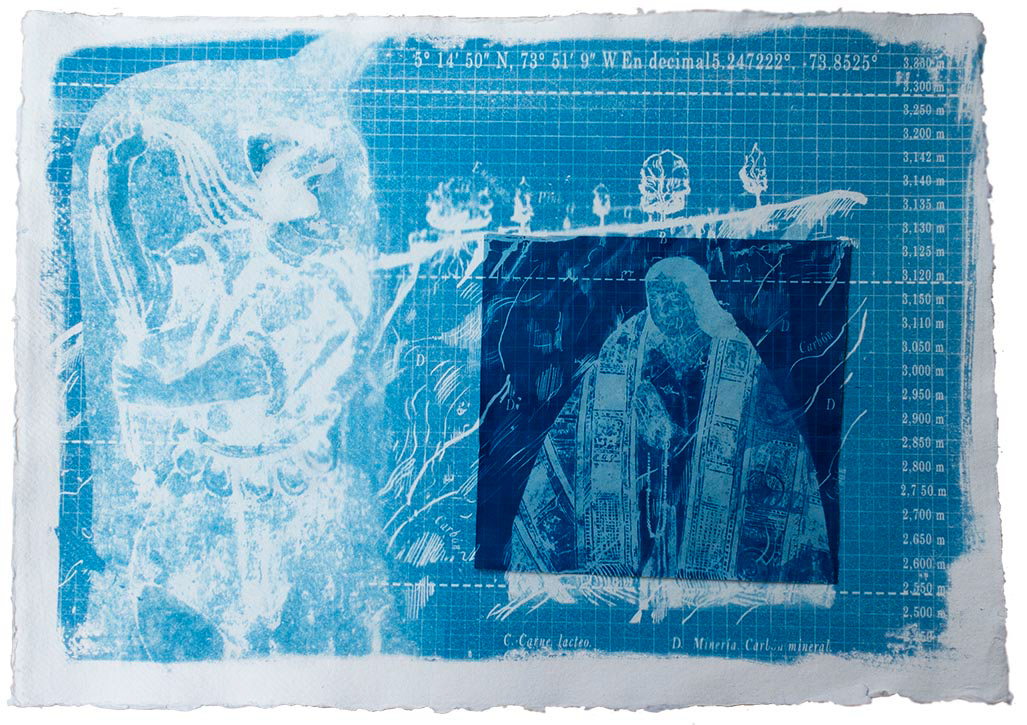
Blue Print Sutatausa N. 9.Cyanotype on cotton paper
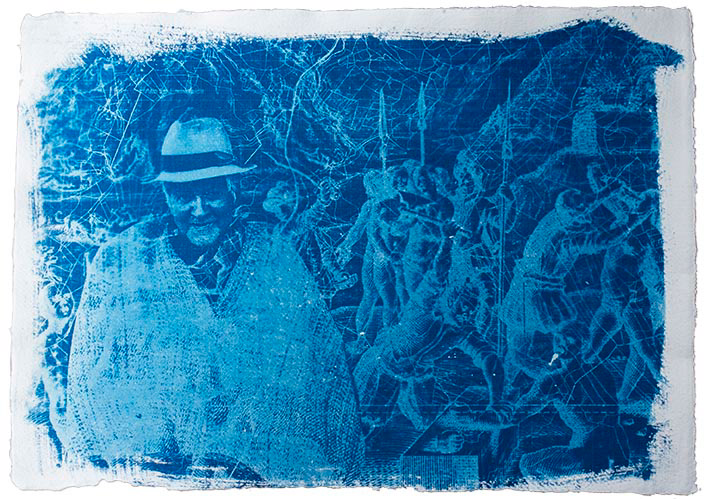
Blue Print Sutatausa N. 7. Cyanotype
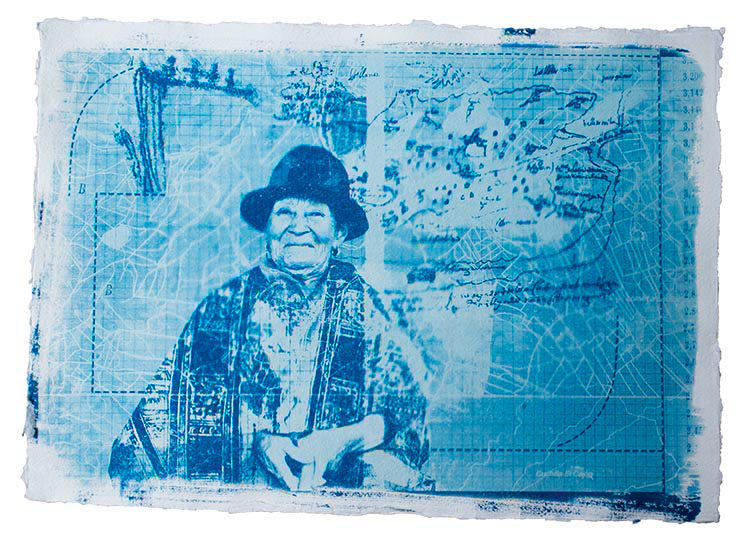
Blue Print Sutatausa N. 8. Cyanotype
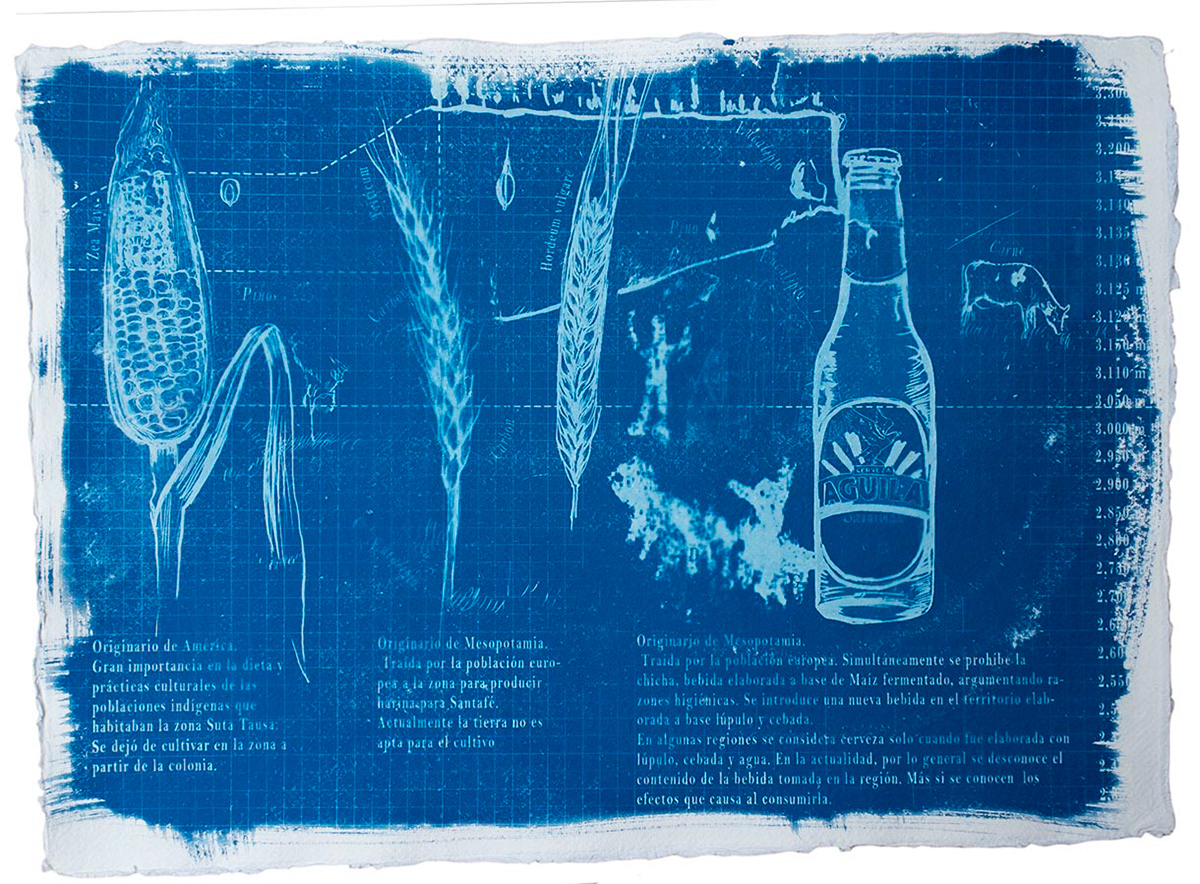
Blue Print Sutatausa N. 6.
In Sutatausa Blue Prints the bodies of female farmers and Mestizo women occupy the foreground on top of a blueprint background, a technique which allows Cote to unveil and contrast through lines, grids and cooler planes. In the Cyanotype on cotton paper by the name of Blue Print Sutatausa N. 9, the absence of evocative names or titles is in itself a commentary based on the typical denominations present in series about characters and landscapes intervened by bio-social extractivist. A Grandmother from that region whose name is that of her village and not that of her ethnic group stares at us with a beautiful expression, a clear smile and her hands joined together, even if relaxed, they are forming a gesture that differentiates from the devotional and evangelized hands of the Sutatausa “cacica”, depicted with a rosary between her hands on one of the walls of the doctrinal temple of the 17th century.
Here, the palimpsest occurs as much in the visual overlap of the “cacica’s” cloak, which generates a meta-portrait ( a portrait of the portrait), as in the tension on the background in which are congregating both the grids of the machine plane as well as the map attributed to the Mestizo cacique (native chief) Don Diego de Torres y Moyachoque. In said map of the Santafé Province, dated back to the 1570’s, the territory of the Muiscas and other native peoples is seen reduced to “Encomiendas” and exclusively indigenous villages, such as Sutatausa and Turmequé. Half erased, half visible, the territory appears by then already partially unoccupied, genetically re-located, reduced and even at the beginning of a systematic extractivist project, with many layers and delays, as is evidenced in the Palimpsests: deforestation, the replacement of corn by wheat, the “Chicha” (fermented corn drink) replaced by beer and the current mining exploitation in the area.
Here, the palimpsest occurs as much in the visual overlap of the “cacica’s” cloak, which generates a meta-portrait ( a portrait of the portrait), as in the tension on the background in which are congregating both the grids of the machine plane as well as the map attributed to the Mestizo cacique (native chief) Don Diego de Torres y Moyachoque. In said map of the Santafé Province, dated back to the 1570’s, the territory of the Muiscas and other native peoples is seen reduced to “Encomiendas” and exclusively indigenous villages, such as Sutatausa and Turmequé. Half erased, half visible, the territory appears by then already partially unoccupied, genetically re-located, reduced and even at the beginning of a systematic extractivist project, with many layers and delays, as is evidenced in the Palimpsests: deforestation, the replacement of corn by wheat, the “Chicha” (fermented corn drink) replaced by beer and the current mining exploitation in the area.
In fact, on the original footnote from the maps attributed to the “cacique” of Turmequé it is said that there were no longer any indigenous people left in the Province. Thus making it meaningful that in the Blue Print Cote erases said footnote on a map which anticipates the extractive planes/ blueprints[cm1] at the same time that the “Cacica” stares at us smiling while affirming her presence with such resilience and sense of humour that it transcends the “cacique’s” inevitable pessimism at the end of the 16th Century.
The Sutatausa territory, that Jose Luis Cote is visually pondering about, despite the fragmentation and abandonment of its painted Muisca rocks and the current residues of a stern religious and ideological control over the local populations, is re-dignified through the smiling and fully present gestures.
The Sutatausa territory, that Jose Luis Cote is visually pondering about, despite the fragmentation and abandonment of its painted Muisca rocks and the current residues of a stern religious and ideological control over the local populations, is re-dignified through the smiling and fully present gestures.
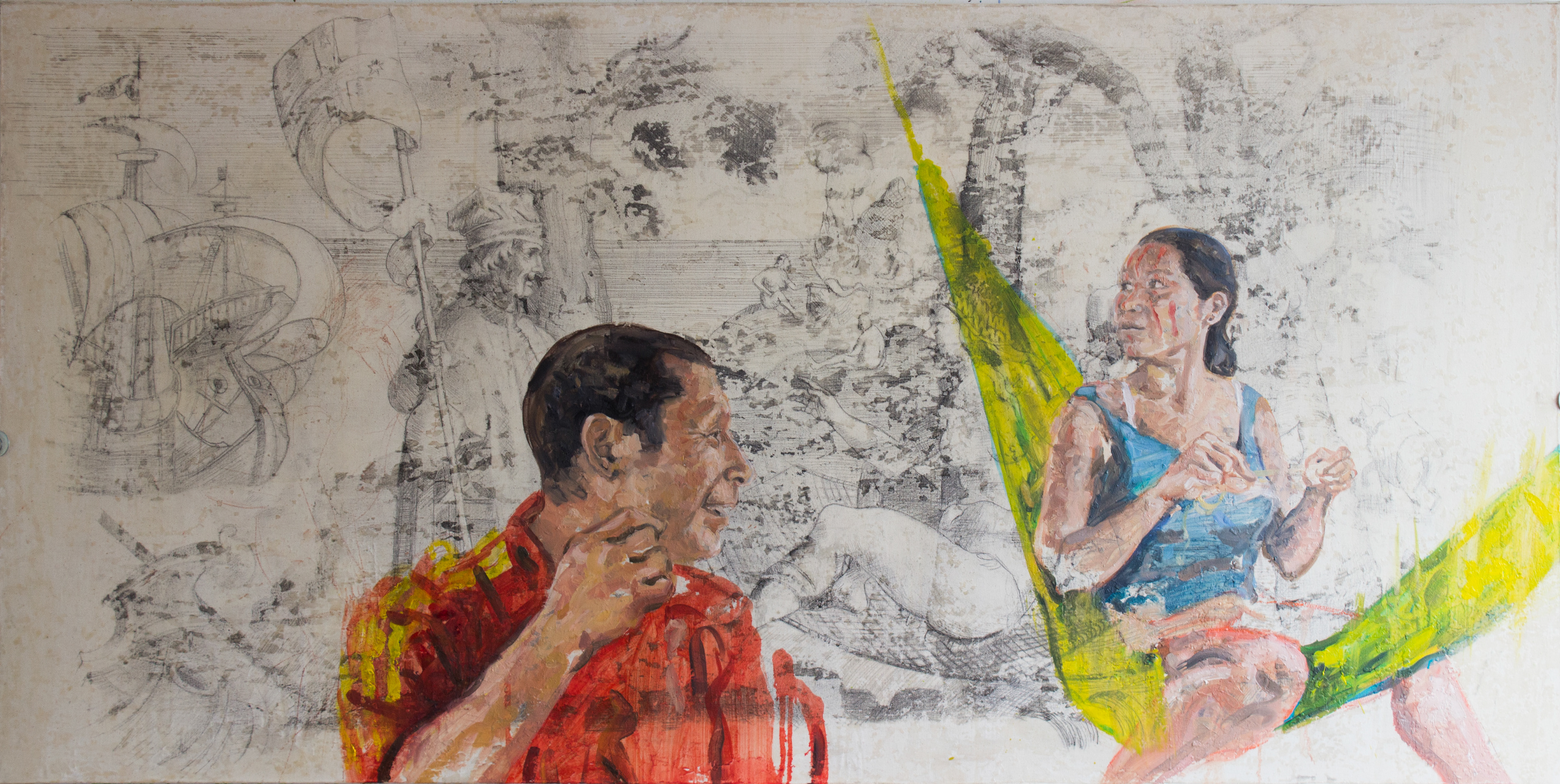
Nükaks over the Interpretation of indigenous according to a European Theodor Galle after Johannes Stradanus . Pencils and Oil on canvas
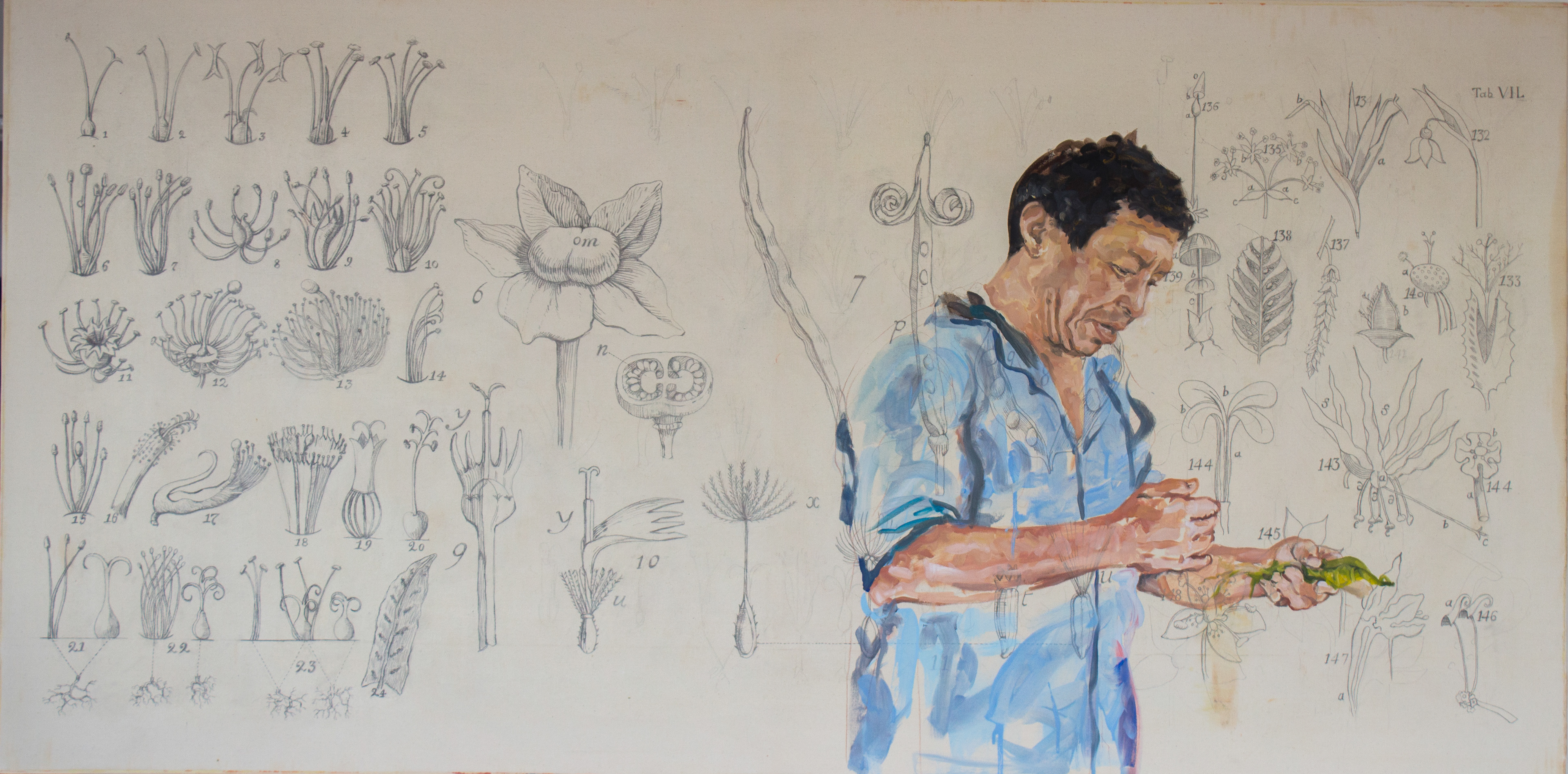
“Payé” Luis. Pencils and Oil on canvas
In turn, the Jiw and Nükak women from the Palimpsests, despite the current population reductions caused by the armed conflict and the prevailing social disorientation, still perform duties as weavers, mothers, transforming forces of life and food, thus keeping their present connected with the Nükak smile, which is now wearing a notorious sports jersey and the serenity of the “payé” Luis, the Tucano wise man expert in medicinal plants. The Amazon is presented as the backdrop upon which once were and are now projected the nightmares and dreams, the idealizations and expropriations of the advanced and “conquering” pasts and presents. Today, as it was before, this immense territory expresses itself in the collective imagination as an apothecary of plants, now classified and studied, just as Linneo and Schultes did. All in all, in the Palimpsests plants are only attributed with colour in the hands of he/she who understands and knows about them, for whom they constitute the path to individual and collective healing.
The Palimpsest, which Jose Luis Cote offers to us as a manner of visual thinking, question the homogenous narratives about our History(ies), re-opens the evidence on the continuity of colonialisms in current times and they articulate a joint critique of the past as well as the present day, of the territory, the people, the socio-biological extractivist, as well as the resistance of common people who have not been carried away by the mainstream. Our Histories are not mere numbers, chronological or magnanimous events; they are evidently palimpsests, never-ending rewritings about previous erasures. And unless we feel, think and see with our own senses and on our own hands and feet, just as Jose Luis Cote is proposing we do, who will rewrite our maps? Who will erase our smile?
Miguel Rocha Vivas.
2018
Writer and intercultural creator.
Translated by Caterina Miani.
Text published in the book Territorio Encarnado, Ejercicios de soberanía visual. Visualidades, textualidades y estéticas situadas en la producción artística indígena en Abya Yala. 2023.
Author: Miguel Rojas Sotelo.
Link: https://www.academia.edu/107354517/Territorio_encarnado
Text published in the book Territorio Encarnado, Ejercicios de soberanía visual. Visualidades, textualidades y estéticas situadas en la producción artística indígena en Abya Yala. 2023.
Author: Miguel Rojas Sotelo.
Link: https://www.academia.edu/107354517/Territorio_encarnado